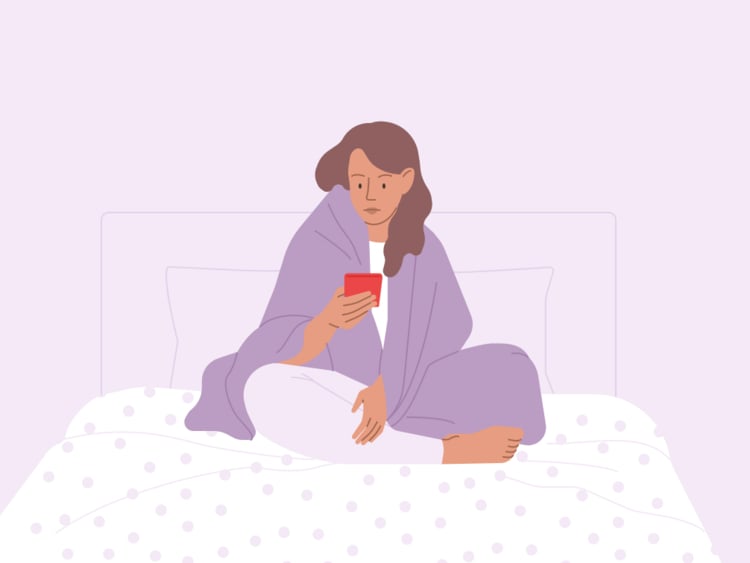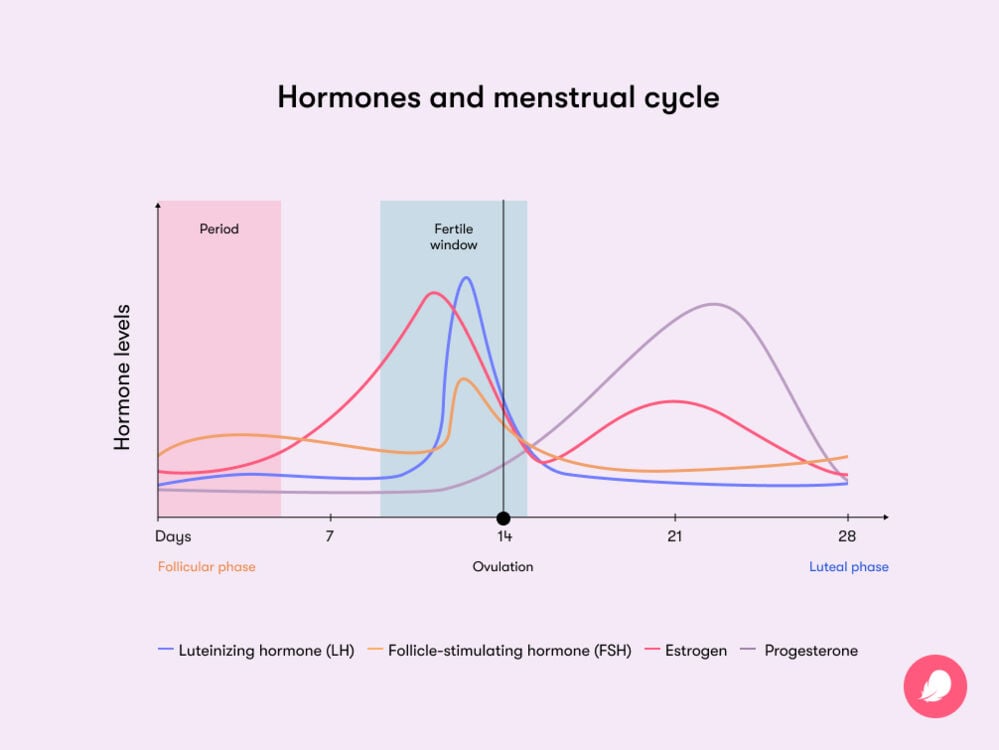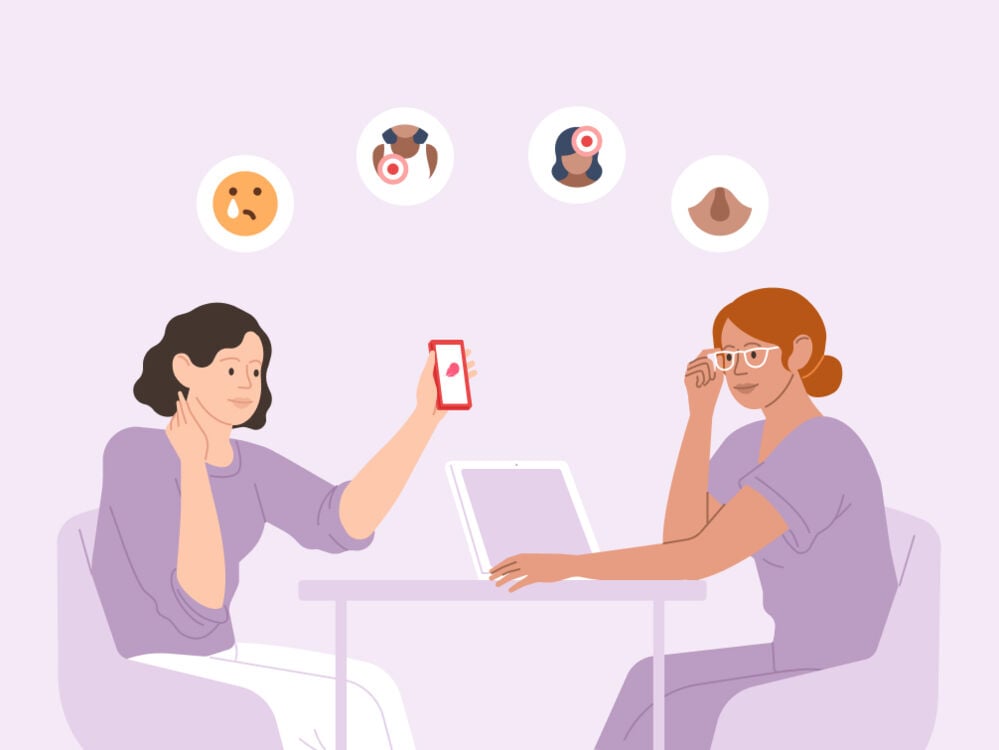Tracking your menstrual cycle can help you understand your body better. And help you feel prepared for the signs and symptoms linked to your period and fertile window.
-
Tracking cycle
-
Getting pregnant
-
Pregnancy
-
Help Center
-
Flo for Partners
-
Anonymous Mode
-
Flo app reviews
-
Flo Premium New
-
Secret Chats New
-
Symptom Checker New
-
Your cycle
-
Health 360°
-
Getting pregnant
-
Pregnancy
-
Being a mom
-
LGBTQ+
-
Quizzes
-
Ovulation calculator
-
hCG calculator
-
Pregnancy test calculator
-
Menstrual cycle calculator
-
Period calculator
-
Implantation calculator
-
Pregnancy weeks to months calculator
-
Pregnancy due date calculator
-
IVF and FET due date calculator
-
Due date calculator by ultrasound
-
Medical Affairs
-
Science & Research
-
Pass It On Project New
-
Privacy Portal
-
Press Center
-
Flo Accuracy
-
Careers
-
Contact Us
How to track your period – and why you should


Every piece of content at Flo Health adheres to the highest editorial standards for language, style, and medical accuracy. To learn what we do to deliver the best health and lifestyle insights to you, check out our content review principles.
So often, the terms cycle and period are used interchangeably — as if they’re the same thing. But your period is only one part of your menstrual cycle. Tracking it could help you understand your body better.
“Your menstrual cycle is considered a ‘vital sign’ of your overall health,” says Dr. Sara Twogood, obstetrician and gynecologist, US, on why she advises that all her patients track their periods. “So if it’s irregular, it might be signaling an underlying issue — something we, as health care providers, need to know about.”
Even if your cycle is fairly regular, “a lot of people will have symptoms throughout the month that might bother them,” she adds. “Cycle tracking can offer an explanation for these symptoms and empower people to predict and manage them better.”
So let’s back up: What is it that you’re actually tracking each month — and how do you do it? With Dr. Twogood’s help, here’s the lowdown on tracking your cycles.
Key takeaways:
- Tracking your menstrual cycle can give you an idea of when your period, ovulation, and fertile window are likely to be each month. No more getting surprised without a period product on the first day of your period.
- Tracking your cycle can also help you to predict and prepare for changes in mood, energy, sex drive, and more.
- Tracking your cycle can be done using an app like Flo, an old-fashioned calendar, or a notebook to log your symptoms.
- The key bits of information to keep tabs on are the dates of the first day of each period, how long your periods are, and any symptoms you notice (e.g., cramps).
- If you’re on certain forms of hormonal birth control, you may not have any periods to track. However, it can be useful to keep a log of your side effects in a similar way. Plus, Flo can give you birth control reminders.
Take a quiz
Find out what you can do with our Health Assistant
What are the phases of the menstrual cycle?
Before we get into the best ways you can track your menstrual cycle, it’s good to understand more about what it is.
The menstrual cycle is the phrase used to describe the process that your body goes through every month when it prepares for a potential pregnancy. Your cycle starts on the first day of a new period and ends the day before your next period. While the average cycle length is around 28 days, if yours is between 21 and 35 days, then yours will be considered normal.
Your period is monumental in kicking off a new cycle. However, other processes and hormonal changes mean that a lot of other things are going on in your body throughout your cycle.
When you start to track your cycle, it can be helpful to think of your cycle as two phases: the follicular phase and the luteal phase.
Follicular phase
The follicular phase is the first part of your cycle. It starts on the first day of your period and runs until the day before one of your ovaries releases an egg to be potentially fertilized, which is known as ovulation.
As your cycle is very personal to you, it can be hard to say how long your follicular phase lasts. It can change from cycle to cycle and over time. This part of your cycle typically ranges from around 14 to 21 days.
Your period isn’t the only notable event during your follicular phase. Hormones called follicle-stimulating hormone and estrogen are released, which prompt small fluid-filled sacs called follicles to grow and develop in your ovaries. Each of these follicles contains an egg, and one of these eggs may be released during ovulation.

Ovulation
While ovulation isn’t classed as an official phase of your cycle, it’s still a pretty big deal. Generally, ovulation happens around 14 days before your next period. So if you have a 28-day cycle, this would be around day 14.
Once one of the eggs matures, your body releases a hormone called luteinizing hormone, which triggers its release from the follicle. It may then pass from your ovary down your uterine or fallopian tubes to potentially be fertilized by a sperm. If you have unprotected sex during this part of your cycle (and even a few days before or after ovulation), you have a high chance of getting pregnant. This marks out your fertile window — the five days before ovulation and the day after.
Luteal phase
The second part of your cycle is known as the luteal phase and begins after ovulation. It runs all the way up until the day before a new period. During your luteal phase, your progesterone levels rise, which causes the lining of your uterus to thicken. This is crucial if the egg you released during ovulation was fertilized by a sperm. If the lining of the walls of your uterus is thick, it helps your fertilized egg to attach firmly and grow.
If you don’t become pregnant this cycle, then your estrogen and progesterone levels begin to decrease. This can cause the lining of your uterus to break down, shed, and leave your body in the form of your period. And a new period marks the start of a new cycle.
How to track your period
There are a few different ways to track your cycle. So it’s all about what works for you. But first — what are the main dates and pieces of information you should keep tabs on?
“The date of the first day of each period is key,” says Dr. Twogood, “because that alone holds so much information. It tells us how long your cycles are and means we can predict when your period and fertile days will be each month.”
“I also like to know how many days someone’s periods run for,” she adds, “because heavy bleeding can be a sign of something going on medically.”
Alongside the dates of your period, you can also keep note of any other symptoms or changes in the way you feel. “It might be cramps, breast tenderness, mood swings, changes in sex drive. Having a log of when these things are happening can help you predict and prepare for them or help you get support from your doctor if you need it.”
So, now that you know what to keep note of, here’s how you can do it.
Use a cycle-tracking app
Using an app tends to be Dr. Twogood’s go-to recommendation. In her words, it’s the easiest way for people to “get a baseline for their individual cycle and its variations.” Since your cycle is individual to you, an app can help you spot patterns and keep your symptoms and period data all in one place.
With a period-tracking app like Flo, all you need to do is log your period dates each month. Once you’ve logged a couple of cycles, you might notice that the period dates predicted in the app start to sync with your cycle. You can also see when your fertile window might be, plus what symptoms you might experience (including changes in mood, energy, and sex drive, alongside physical symptoms like cramps, bloating, and breakouts).
You can log any symptoms that you experience through the symptom tracker and start to spot patterns across your cycles. This helps you understand what’s typical for you — so you’re more prepared to manage it and more aware when something’s not normal (so you can flag it with a doctor).
On that note, Flo’s Report for a doctor feature provides a downloadable report of your last six cycles — containing all of the info Dr. Twogood mentioned above and more in one easy place.
Grab a pen and your calendar
If downloading an app doesn’t feel right for you, you can figure out roughly when to expect your period — and keep a record of certain key details for your health care provider — using just a pen and calendar.
- Using a symbol like a red circle, cross, or drop, make a note of your period days each month: the date it starts and how many days it lasts. After a few cycles, you may be able to get an idea of what a “typical” period length is for you.
- Next, you want to look at how long your cycles are. The first day of your period is the first day of a new cycle — so to count the days in a cycle, you need to count how many days there are from the first day of one period to the first day of the next period. Do this over several months to get an idea of what a “typical” cycle length is for you.
- Now you can start to predict when your periods are due. Starting on the first day of your most recent period (aka day one), count out the average number of days your cycle typically lasts. The day after your current cycle is set to end is around the time your next period should begin. You can add a reminder to your calendar on this day.
Keep in mind that periods don’t happen like clockwork. Cycle lengths can (and do) vary across months. Plus, various things can cause a late period, like stress, overexercising, or weight change.

Make a note of your symptoms
If you don’t want to log cycle-related symptoms in an app, you can keep a note of changes in the way you feel in a notebook, on a calendar, or on your phone. If you do this for a few cycles, you may be able to spot symptoms that are recurring before your periods (e.g., mood swings, sore boobs, skin breakouts, bloating) and come to understand them as possible signs your period is coming each month.
You can also use it to understand what can be “normal” for you at various stages of your cycle and have the information handy for your health care provider should you need it.
What if I’m on birth control?
If you take hormonal birth control, you may not have a period to track. Most forms of hormonal birth control work by stopping ovulation, and this means you won’t have a period. If you have an implant or intrauterine device, you may not experience period-like bleeding throughout the month. However, some hormonal birth control options can cause a withdrawal bleed.
It’s important to note that a withdrawal bleed isn’t the same as a period. If you’re on the combined pill, patch, or ring, and your course involves either taking inactive pills or taking breaks between packets, you’ll be having “withdrawal bleeds,” which can feel like a period.
Similarly, spotting, or light bleeding between your periods, can be a side effect of birth control. While you may not have a period, there are still benefits to tracking your cycle if you’re on hormonal birth control, says Dr. Twogood. You can log any symptoms and side effects you’re having as a result of your birth control.
“For example, if someone is worried that they’re having quite a bit of spotting,” she says, “it can be helpful to track how often and the number of days it’s lasting. That data might help them see that actually it’s not as extreme as they thought — or validate them in wanting to go to their doctor and change something. Both are important.”
Why cycle tracking matters
If you’re still not totally sure, here are some of the best reasons to start tracking your cycle:
- It can give you a clear idea of when to expect your period and fertile window each month.
- It can help you understand, predict, and prepare for cycle-related symptoms and changes, such as changes in your mood, energy levels, sex drive, and more.
- It can help you (and your doctor) notice irregularities in your cycle — which could be a sign of an underlying health issue.
What is the menstrual cycle?
It’s a cycle of changes your body goes through to prepare for a possible pregnancy each month, driven by hormonal changes. A new cycle starts on the first day of your period and runs until the first day of your next one.
What counts as the first day of your period?
Some people experience spotting before their period, which is lighter blood or bloody discharge that you may notice on toilet tissue when you wipe. But the first day of your period is the day that full-flow bleeding begins — the kind that you need a period product, like a pad or tampon, to manage.
How do I know my period is here?
As we said, that flow of blood from your vagina is the sign it’s officially “here.” You can also often guess that it’s near if you experience common premenstrual syndrome or pre-period symptoms like mood swings, cramping, or sore boobs.


Hey, I'm Anique
I started using Flo app to track my period and ovulation because we wanted to have a baby.


The Flo app helped me learn about my body and spot ovulation signs during our conception journey.


I vividly
remember the day
that we switched
Flo into
Pregnancy Mode — it was
such a special
moment.
Real stories, real results
Learn how the Flo app became an amazing cheerleader for us on our conception journey.
References
“Abnormal Uterine Bleeding.” The American College of Obstetricians and Gynecologists, Dec. 2021, www.acog.org/womens-health/faqs/abnormal-uterine-bleeding.
“Birth Control.” Mayo Clinic, 2 Dec. 2022, www.mayoclinic.org/healthy-lifestyle/birth-control/in-depth/womens-health/art-20044044.
“Calculating Your Monthly Fertility Window.” Johns Hopkins Medicine, www.hopkinsmedicine.org/health/wellness-and-prevention/calculating-your-monthly-fertility-window. Accessed 1 July 2024.
“Can Stress Cause You to Skip a Period?” Cleveland Clinic, 18 Sep. 2020, health.clevelandclinic.org/can-stress-cause-you-to-skip-a-period.
“Combination Birth Control Pills.” Mayo Clinic, 13 Jan. 2023, www.mayoclinic.org/tests-procedures/combination-birth-control-pills/about/pac-20385282.
“Combined Hormonal Birth Control: Pill, Patch, and Ring.” The American College of Obstetricians and Gynecologists, Nov. 2023, www.acog.org/womens-health/faqs/combined-hormonal-birth-control-pill-patch-ring.
Dufau, M. L. “The Luteinizing Hormone Receptor.” Annual Review of Physiology, vol. 60, Mar. 1998, pp. 461–96, https://doi.org/10.1146/annurev.physiol.60.1.461.
“Follicular Phase.” Cleveland Clinic, my.clevelandclinic.org/health/body/23953-follicular-phase. Accessed 1 July 2024.
“Follicular Phase.” ScienceDirect, www.sciencedirect.com/topics/biochemistry-genetics-and-molecular-biology/follicular-phase. Accessed 1 July 2024.
Houghton, Lauren C. “Menstruation as the Next Vital Sign.” JAMA Network Open, vol. 7, no. 5, May 2024, doi:10.1001/jamanetworkopen.2024.12778.
“How to Take the Combined Pill.” NHS, www.nhs.uk/contraception/methods-of-contraception/combined-pill/how-to-take-it/. Accessed 1 July 2024.
“Is It Normal to Lose Your Period Because of Exercise?” Cleveland Clinic, 2 Feb. 2021, health.clevelandclinic.org/is-it-normal-to-lose-your-period-because-of-exercise.
Jacobson, Melanie H., et al. “Hormonal Profiles of Menstrual Bleeding Patterns during the Luteal-Follicular Transition.” The Journal of Clinical Endocrinology and Metabolism, vol. 105, no. 5, May 2020, pp. E2024–31, https://doi.org/10.1210/clinem/dgaa099.
“Menstrual Cycle.” Cleveland Clinic, my.clevelandclinic.org/health/articles/10132-menstrual-cycle. Accessed 1 July 2024.
“Menstrual Cycle: What’s Normal, What’s Not.” Mayo Clinic, 22 Apr. 2023, www.mayoclinic.org/healthy-lifestyle/womens-health/in-depth/menstrual-cycle/art-20047186.
“Ovulation.” Cleveland Clinic, my.clevelandclinic.org/health/articles/23439-ovulation. Accessed 1 July 2024.
Penzias, Alan S. “Luteal Phase Support.” Fertility and Sterility, vol. 77, no. 2, Feb. 2002, pp. 318–23, https://doi.org/10.1016/S0015-0282(01)02961-2.
“Premenstrual Syndrome (PMS).” Mayo Clinic, 25 Feb. 2022, www.mayoclinic.org/diseases-conditions/premenstrual-syndrome/symptoms-causes/syc-20376780.
“The Menstrual Cycle: Menstruation, Ovulation, and How Pregnancy Occurs.” The American College of Obstetricians and Gynecologists, Jan. 2022, www.acog.org/womens-health/infographics/the-menstrual-cycle.
Thiyagarajan, Dhanalakshmi K., et al. “Physiology, Menstrual Cycle.” StatPearls, StatPearls Publishing, 2022, www.ncbi.nlm.nih.gov/books/NBK500020/.
“Vaginal Bleeding.” Mayo Clinic, 2 May 2023, www.mayoclinic.org/symptoms/vaginal-bleeding/basics/definition/sym-20050756.
French, Valerie.“What You Should Know about Breakthrough Bleeding with Birth Control.” The American College of Obstetricians and Gynecologists, Jan. 2021, www.acog.org/womens-health/experts-and-stories/the-latest/what-you-should-know-about-breakthrough-bleeding-with-birth-control.
Wilcox, A. J., et al. “The Timing of the ‘Fertile Window’ in the Menstrual Cycle: Day Specific Estimates from a Prospective Study.” BMJ, vol. 321, no. 7271, Nov. 2000, pp. 1259–62, https://doi.org/10.1136/bmj.321.7271.1259.




